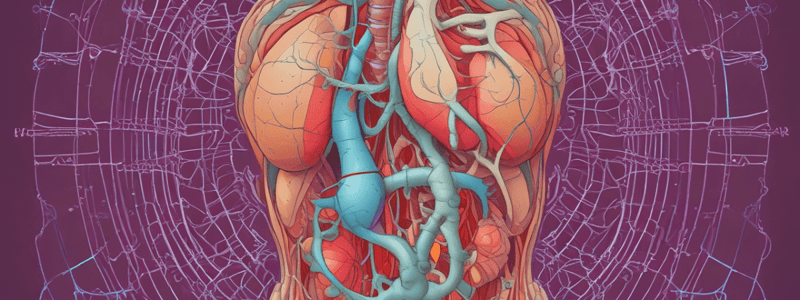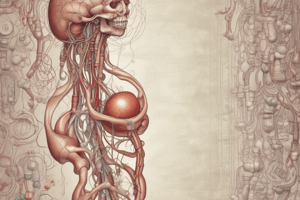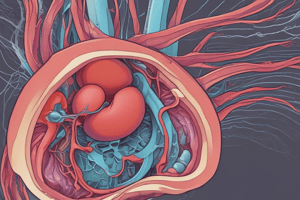Podcast
Questions and Answers
What is the primary function of the urinary system in regard to waste management?
What is the primary function of the urinary system in regard to waste management?
- Conserving sodium in the blood
- Excreting metabolic waste products (correct)
- Maintaining blood pressure
- Regulating blood pH levels
What is the role of the kidney in regulating blood pressure?
What is the role of the kidney in regulating blood pressure?
- Secretion of aldosterone to conserve sodium
- Secretion of renin to increase blood pressure (correct)
- Filtration of chloride ions
- Reabsorption of potassium ions
What is the significance of sodium in the urinary system?
What is the significance of sodium in the urinary system?
- It is essential for the reabsorption of water
- It is a key electrolyte in maintaining blood volume (correct)
- It is a waste product excreted in the urine
- It helps in regulating blood pH levels
What is the net effect of the urinary system on blood pH levels?
What is the net effect of the urinary system on blood pH levels?
What is the primary function of the urinary system in regard to blood composition?
What is the primary function of the urinary system in regard to blood composition?
What is the relationship between the kidney and blood volume?
What is the relationship between the kidney and blood volume?
What is the function of the kidneys in regulating electrolytes?
What is the function of the kidneys in regulating electrolytes?
What is the function of Calcitriol in the kidneys?
What is the function of Calcitriol in the kidneys?
What is the name of the outermost layer of the kidney that connects it to the abdominal wall and diaphragm?
What is the name of the outermost layer of the kidney that connects it to the abdominal wall and diaphragm?
What is the term for the dropping of the kidney from the supine to erect position?
What is the term for the dropping of the kidney from the supine to erect position?
What is the name of the functional unit of the kidney that is responsible for filtering waste and excess substances from the blood?
What is the name of the functional unit of the kidney that is responsible for filtering waste and excess substances from the blood?
What is the name of the tube that connects the kidney to the bladder and allows for the passage of urine?
What is the name of the tube that connects the kidney to the bladder and allows for the passage of urine?
What is the function of the renal cortex in the kidney?
What is the function of the renal cortex in the kidney?
What is the name of the indented area on the medial side of the kidney where the renal artery, renal vein, and ureter enter?
What is the name of the indented area on the medial side of the kidney where the renal artery, renal vein, and ureter enter?
What is the term for the movement of the diaphragm during inhalation that helps to facilitate the flow of urine through the kidneys?
What is the term for the movement of the diaphragm during inhalation that helps to facilitate the flow of urine through the kidneys?
How many pyramids are typically found in the renal medulla of the kidney?
How many pyramids are typically found in the renal medulla of the kidney?
What percentage of the resting cardiac output does the kidneys receive?
What percentage of the resting cardiac output does the kidneys receive?
Which part of the nephron is not located in the renal cortex?
Which part of the nephron is not located in the renal cortex?
What is the function of the Juxtaglomerular Complex?
What is the function of the Juxtaglomerular Complex?
What is the name of the artery that supplies each segment of the kidney?
What is the name of the artery that supplies each segment of the kidney?
What is the main function of the Glomerular Capsule?
What is the main function of the Glomerular Capsule?
What is the term for the process of filtering blood plasma in the glomerulus?
What is the term for the process of filtering blood plasma in the glomerulus?
What is the approximate thickness of the filtration membrane in the glomerulus?
What is the approximate thickness of the filtration membrane in the glomerulus?
What is the term for the pressure that drives filtration in the glomerulus?
What is the term for the pressure that drives filtration in the glomerulus?
What is the name of the cells that relax or contract to regulate the surface area of the glomerulus?
What is the name of the cells that relax or contract to regulate the surface area of the glomerulus?
What is the term for the process of reabsorbing water and electrolytes from the filtrate back into the bloodstream?
What is the term for the process of reabsorbing water and electrolytes from the filtrate back into the bloodstream?
What is the primary force responsible for the formation of filtrate in the glomerulus?
What is the primary force responsible for the formation of filtrate in the glomerulus?
What is the result of the Net Filtration Pressure (NFP) equation?
What is the result of the Net Filtration Pressure (NFP) equation?
What happens to the Glomerular Filtration Rate (GFR) if the afferent arteriole dilates?
What happens to the Glomerular Filtration Rate (GFR) if the afferent arteriole dilates?
What is the function of the renal autoregulation mechanism?
What is the function of the renal autoregulation mechanism?
What is the purpose of the tubuloglomerular feedback mechanism?
What is the purpose of the tubuloglomerular feedback mechanism?
What is the result of a Glomerular Filtration Rate (GFR) that is too high?
What is the result of a Glomerular Filtration Rate (GFR) that is too high?
What is the role of the stretch receptors in the myogenic mechanism?
What is the role of the stretch receptors in the myogenic mechanism?
What is the effect of chronic kidney disease on renal autoregulation?
What is the effect of chronic kidney disease on renal autoregulation?
What is the purpose of the eGFR calculation?
What is the purpose of the eGFR calculation?
What is the relationship between the Glomerular Filtration Rate (GFR) and the Net Filtration Pressure (NFP)?
What is the relationship between the Glomerular Filtration Rate (GFR) and the Net Filtration Pressure (NFP)?
What is the effect of increased sodium and chlorine ions on the glomerulus?
What is the effect of increased sodium and chlorine ions on the glomerulus?
What is the effect of sympathetic nerve stimulation on renal blood flow and GFR?
What is the effect of sympathetic nerve stimulation on renal blood flow and GFR?
What is the role of angiotensin II in renal autoregulation?
What is the role of angiotensin II in renal autoregulation?
What is the primary function of tubular reabsorption?
What is the primary function of tubular reabsorption?
What is the function of the antiporter Na+-H+ in the proximal convoluted tubule?
What is the function of the antiporter Na+-H+ in the proximal convoluted tubule?
What is the role of the loop of Henle in tubular reabsorption?
What is the role of the loop of Henle in tubular reabsorption?
What is the function of the principal cells in the collecting duct?
What is the function of the principal cells in the collecting duct?
What is the effect of atrial natriuretic peptide (ANP) on renal blood flow and GFR?
What is the effect of atrial natriuretic peptide (ANP) on renal blood flow and GFR?
What is the role of the macula densa in tubuloglomerular feedback?
What is the role of the macula densa in tubuloglomerular feedback?
What is the role of the intercalated cells in the collecting duct?
What is the role of the intercalated cells in the collecting duct?
Which hormone stimulates the release of aldosterone?
Which hormone stimulates the release of aldosterone?
What is the primary function of the urinary bladder?
What is the primary function of the urinary bladder?
Where does the ureter enter the bladder?
Where does the ureter enter the bladder?
What is the effect of high Antidiuretic Hormone (ADH) levels on urine output?
What is the effect of high Antidiuretic Hormone (ADH) levels on urine output?
Which structure is responsible for moving urine from the kidney to the urinary bladder?
Which structure is responsible for moving urine from the kidney to the urinary bladder?
What is the function of the renal cortex?
What is the function of the renal cortex?
Which hormone has a role in regulating facultative water reabsorption?
Which hormone has a role in regulating facultative water reabsorption?
What is the location of the ureteropelvic junction?
What is the location of the ureteropelvic junction?
What is the effect of Angiotensin II on the glomerular filtration rate (GFR)?
What is the effect of Angiotensin II on the glomerular filtration rate (GFR)?
Which structure is anterior to the symphysis pubis?
Which structure is anterior to the symphysis pubis?
If GBHP passes below ___... no filtration
If GBHP passes below ___... no filtration
Glomerular Blood Hydrostatic Pressure should =
Capsular Hydrostatic Pressure should =
Blood Colloid Osmotic Pressure should =
Glomerular Blood Hydrostatic Pressure should = Capsular Hydrostatic Pressure should = Blood Colloid Osmotic Pressure should =
NFP Increases if afferent arteriole ____ and efferent arteriole _____.
NFP Increases if afferent arteriole ____ and efferent arteriole _____.
Would not inject contrast in patient who's eGFR is?
Would not inject contrast in patient who's eGFR is?
eGFR of kidney failure is?
eGFR of kidney failure is?
Two mechanisms of renal autoregulation are?
Two mechanisms of renal autoregulation are?
T or F, Tubulorglomerular feedback inhibits the release of nitric oxide from cells, causing constriction of of afferent artieroles
T or F, Tubulorglomerular feedback inhibits the release of nitric oxide from cells, causing constriction of of afferent artieroles
Angiotension II is a _____
Angiotension II is a _____
T or F, Angiotenson II increases GFR
T or F, Angiotenson II increases GFR
Atrial Natriuretic Peptide does what?
Atrial Natriuretic Peptide does what?
T or F ANP (atrial natriuretic peptide) increases GFR
T or F ANP (atrial natriuretic peptide) increases GFR
T or F antiporters are mb proteins that move 2 or more substances in opposite directions and symporters move in same direction
T or F antiporters are mb proteins that move 2 or more substances in opposite directions and symporters move in same direction
Obligatory water resorption (90%) occurs where? and Facultative water resorption (10%) happens where?
Obligatory water resorption (90%) occurs where? and Facultative water resorption (10%) happens where?
Majority of water is absorbed?
Majority of water is absorbed?
Descending loop of henle is permeable to ____while ascending is permeable to _____
Descending loop of henle is permeable to ____while ascending is permeable to _____
Flashcards are hidden until you start studying
Study Notes
Urinary System Overview
- The urinary system excretes waste products in the urine, regulates blood volume, blood composition, blood pressure, and blood pH.
- It also regulates blood glucose levels and produces hormones that regulate calcium homeostasis and stimulate the production of red blood cells.
Functions of the Urinary System
- Excrete waste products in the urine, including:
- Urea (breakdown of amino acids)
- Creatinine (breakdown of creatine phosphate in muscles)
- Uric acid (catabolism of nucleic acids)
- Bilirubin (catabolism of hemoglobin)
- Regulate blood volume by conserving or eliminating water in the urine
- Regulate blood composition by controlling levels of:
- Sodium
- Potassium
- Calcium
- Chloride
- Phosphate ions
- Regulate blood pressure by secreting renin, which increases blood pressure
- Regulate blood pH by excreting H+ ions and conserving bicarbonate ions in the blood
- Regulate blood glucose levels by producing and releasing glucose into the blood
- Produce hormones that regulate calcium homeostasis (calcitriol) and stimulate the production of red blood cells (erythropoietin)
Important Electrolytes
- Sodium: regulates osmotic gradients and fluid flow, and is involved in action potentials in muscles and nerves
- Potassium: involved in repolarizing membrane potential
- Calcium: important for bone health, blood clotting, and neurotransmitter release
- Magnesium: important for bone health and metabolic reactions
- Phosphate: important for bone health, cell membrane structure, and ATP production
- Bicarbonate: regulates pH and CO2 transport
Renal Anatomy
- Kidneys are located in the abdominal and pelvic cavities
- Right kidney is more inferior than the left kidney
- Kidneys are surrounded by:
- Renal capsule (innermost layer)
- Adipose capsule (middle layer)
- Renal fascia (outermost layer)
- Renal cortex is the outer layer of the kidney, and the renal medulla is the inner layer
- Renal columns are structures that anchor the cortex
- Renal pyramids are cone-shaped structures in the medulla that drain urine into minor calyces
- Minor calyces merge to form major calyces, which merge to form the renal pelvis
- The renal pelvis is the funnel-shaped structure that collects urine from the kidney
Nephron Structure
- The nephron is the functional unit of the kidney
- Each kidney contains approximately 1 million nephrons
- The nephron consists of:
- Renal corpuscle ( Bowman's capsule and glomerulus)
- Renal tubule (proximal convoluted tubule, loop of Henle, and distal convoluted tubule)
- The glomerulus is a network of capillaries that filters the blood
- Bowman's capsule is the double-walled cup that surrounds the glomerulus
- The renal tubule is where reabsorption and secretion of substances take place
Glomerular Filtration
- Glomerular filtration is the process of filtering the blood in the glomerulus
- The net filtration pressure (NFP) is the force that pushes water and solutes out of the blood and into the Bowman's capsule
- NFP is influenced by:
- Glomerular blood hydrostatic pressure
- Capsular hydrostatic pressure
- Blood colloid osmotic pressure
- The glomerular filtration rate (GFR) is the amount of filtrate formed by both kidneys each minute
- GFR is regulated by:
- Renal autoregulation
- Neural regulation
- Hormonal regulation
Hormonal Regulation
- Hormones that regulate GFR include:
- Angiotensin II
- Antidiuretic hormone (ADH)
- Aldosterone
- Atrial natriuretic peptide (ANP)
- Parathyroid hormone (PTH)
Ureters
- Ureters are muscular tubes that transport urine from the kidney to the urinary bladder
- The ureters have a smooth muscle wall that contracts to propel urine through the ureter
- The ureters have a narrow lumen and a thick muscular layer
Urinary Bladder
- The urinary bladder is a temporary storage site for urine
- The bladder has a smooth, trabeculated wall and a trigone that is the point of entry of the ureters
- The bladder has a rugose appearance when empty, and becomes smooth and rounded when full
Urethra
-
The urethra is the tube that carries urine from the bladder out of the body
-
The urethra is shorter in females than in males
-
The urethra has a sphincter that controls the flow of urine### Renal Autoregulation
-
Renal autoregulation maintains a constant GFR despite changes in blood pressure
-
There are three mechanisms: myogenic, tubuloglomerular feedback, and neural regulation
Tubuloglomerular Feedback
- Macula densa provides feedback to the glomerulus
- Detects increased sodium and chloride ions and water in the filtrate
- Inhibits release of nitric oxide, causing constriction of the afferent arterioles
- Operates much slower than the myogenic mechanism
Neural Regulation
- Sympathetic ANS supplies nerves to the kidneys
- At rest, this system is not controlling GFR (renal autoregulation)
- Sympathetic nerve stimulation causes vasoconstriction of the afferent and efferent arterioles
- Decreases renal blood flow and GFR, reducing urine output (conserves water)
- Permits greater blood flow to heart and brain during hemorrhage or severe dehydration
Hormonal Regulation
- Angiotensin II is a potent vasoconstrictor
- Reduces renal blood flow in both afferent and efferent arterioles, reducing GFR
- Atrial Natriuretic Peptide (ANP) relaxes mesangial cells, increasing GFR
Tubular Reabsorption
- In 45 minutes, more fluid has entered the PCT than there is total blood volume
- Most of the filtrate is reabsorbed from the tubules back into the bloodstream
- Water, glucose, proteins, urea, ions (Na+, Cl-, Ca2+, K+) are reabsorbed
- Passive transport: no energy required
- Active transport: requires energy, uses symporters and antiporters
Water Reabsorption
- 99% of water is reabsorbed
- Solute reabsorption drives water reabsorption
- Occurs via osmosis (passive transport)
- Obligatory Water Reabsorption (90%): PCT and descending Loop of Henle
- Facultative Water Reabsorption (10%): regulated by ADH in the DCT and collecting ducts
Tubular Secretion
- Movement of substances from the capillaries into the filtrate
- Occurs at a site other than the filtration membrane
- Controls pH by secreting hydrogen and ammonium ions and conserving bicarbonate
- Regulates sodium, potassium, magnesium, phosphate, and sulfate ions
Reabsorption in Different Segments
- PCT: 65% of glucose and amino acids, active transport of sodium, potassium, magnesium, phosphate, and sulfate ions
- Loop of Henle: sodium, potassium, chloride, calcium, and magnesium ions
- DCT: 95% of water and solutes reabsorbed, regulated by ADH and aldosterone
Hormones and Homeostasis
- Five hormones affect the extent of Na+, Cl-, Ca2+, and water reabsorption as well as K+ secretion by the renal tubules
- Hormones involved in homeostasis: ADH, aldosterone, and others
Studying That Suits You
Use AI to generate personalized quizzes and flashcards to suit your learning preferences.




